We’ve been talking about towing quite a lot lately. Continuing on that popular RVing topic, today we’re covering the subject of the RV tow dolly.
When you travel in a motorhome, as we have for nearly 2 decades, it’s pretty important for most RVers to tow a smaller vehicle along for trips into a nearby town, to explore the local area, shop for groceries, doing laundry, etc.
It can be difficult to navigate the streets of a large city, small-town roads, or many areas in National Parks in a Class A RV. And who wants to break camp to drive the RV into town for dinner? So, for the entire time we’ve been living on the road in an RV, we’ve flat-towed a vehicle along with us.
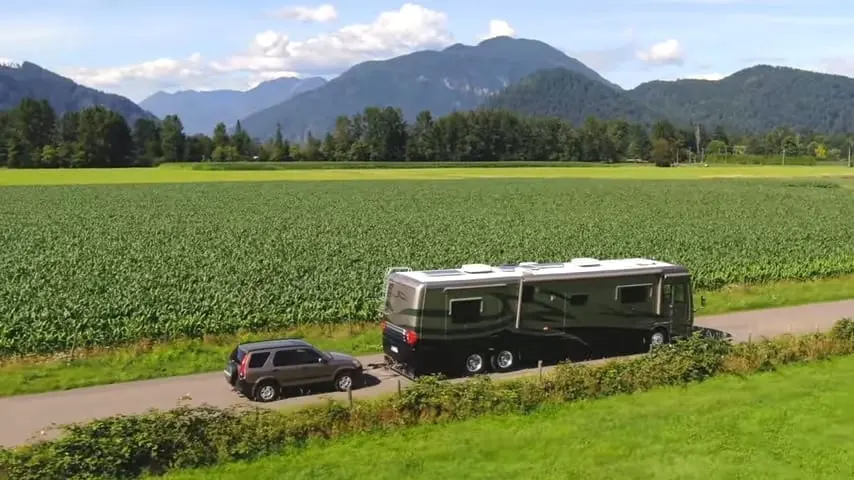
There are a few ways to tow a vehicle behind your RV. You can use a tow dolly, you can flat-tow as we do, or you can pull a full-size car trailer. In this post, we’re going to focus on the option of using a tow dolly, because full-size trailers are cumbersome, and not all cars can be flat-towed (towed with all four wheels on the ground). Dollies split the difference. Think of them as trailers that have been cut in half!
What is an RV Tow Dolly?
An RV tow dolly is a two-wheel trailer that pulls a (usually front-wheel-drive) car behind your rig. Since most cars these days are front-wheel drive, a dolly is a great option for many RVers, allowing you to bring along a car you already own, even if it isn’t flat towable.
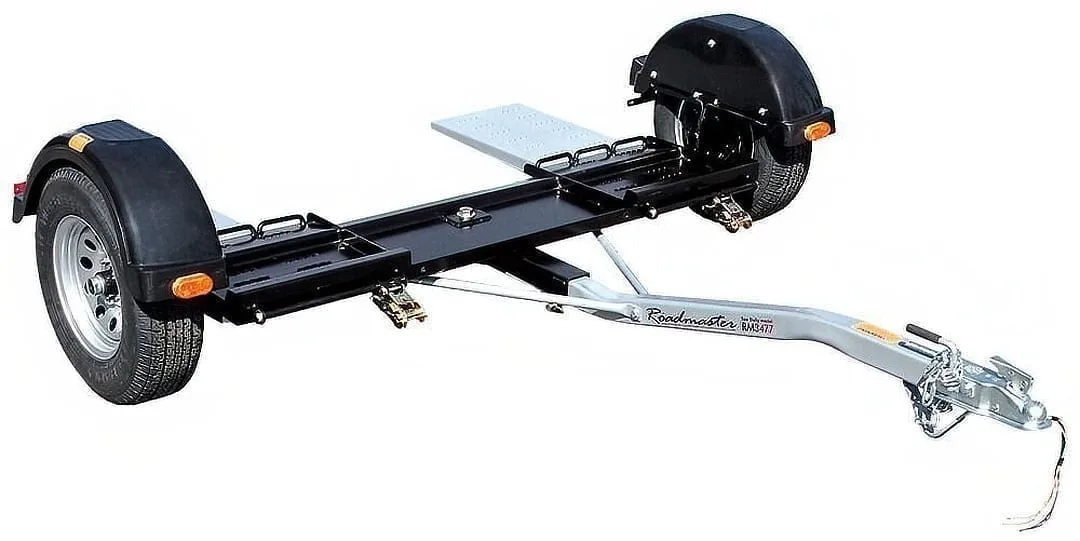
An RV tow dolly, like this model from Roadmaster, is a pretty simple device, allowing you to roll your car onto it and bring it along for the ride.
To use a tow dolly, you’ll connect it to your motorhome’s trailer hitch, drive the car’s front wheels onto the tow dolly, and secure them to each other with straps.
Benefits of Using a Tow Dolly
Aside from enabling you to tow your car, tow dollies are typically equipped with an integrated braking system, which improves safety. It also reduces the wear and tear on your vehicle and won’t increase its mileage since the rear wheels roll freely and the front wheels are on the dolly (although nearly all modern cars with digital odometers won’t rack up miles, even when flat-towing).
A tow dolly is much smaller than a full-size car trailer, requiring far less space to store it after unloading your vehicle. It’s relatively easy to load and unload as well.
If you’re towing a front-wheel-drive vehicle, a tow dolly allows you to pull it without vehicle modifications, whereas with flat-towing, you either need to own (or buy) a year/make/model of car that’s already approved for flat-towing… or you may need to modify your existing car by installing a drive shaft disconnect or other components to prevent transmission damage.
An additional advantage is the ability to tow more than one car (not simultaneously, of course)! If you have more than one car to choose from, maybe you want to bring along your convertible for drives along the coast, but something more rugged when visiting the mountains, or in cooler weather. And of course, that means you can completely switch cars more easily, too, which would come in handy when the time comes to replace your toad.
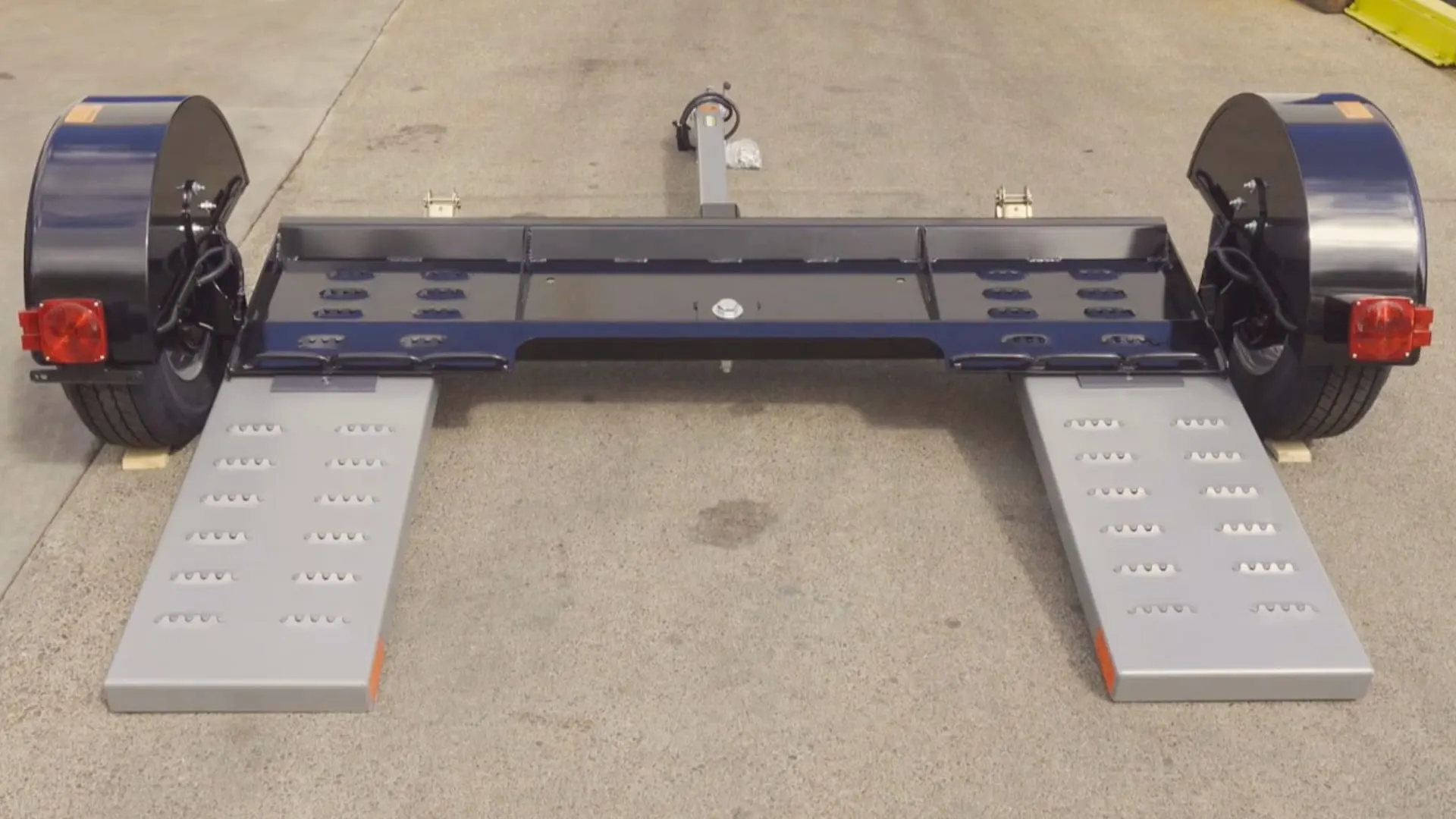
Ramps make it relatively easy to load your towed car onto an RV tow dolly.
That ability to tow more than one vehicle is largely due to the necessity of installing a base plate and auxiliary braking system into any vehicle that you plan to flat tow. Since no base plate or braking system is required for dolly towing (as we mentioned, the dolly already has auxiliary brakes), there’s no (or very little) special setup required.
That brings us to one additional advantage of choosing an RV tow dolly — price. Since the installation of a base plate into the front of the car for flat-towing is often labor-intensive, it can also be expensive. And of course, an auxiliary braking system for the car also comes at a price and/or labor to use/install. Without these two components adding to the overall cost, a tow dolly is typically the least expensive way to bring a car along.
How to Choose an RV Tow Dolly
There are several RV tow dollies on the market, each slightly different from the rest. This means you have a few options to consider, and the decision might come down to your preference. Let’s take a look at some options.
Fixed Wheel vs Steerable/Center Pivot?
When towing a vehicle behind your motorhome, there must be a way for the front 2 wheels in contact with the ground (in this case, the dolly wheels) to “steer”. Otherwise, those front wheels will get dragged sideways while making turns, dramatically reducing their useable lifespan, and putting unnecessary pressure on them, the axles, and the dolly itself.
The simplest, least expensive tow dollies will have a fixed front axle with no built-in means for the front wheels to pivot as your motorhome makes a turn. With this type of dolly, you leave the towed car’s steering unlocked while it’s mounted. This is similar to flat-towing a car four-wheels-down… the front wheels need to be able to turn while being towed, allowing the front of the car to follow the track of the motorhome it’s attached to. With the steering wheels unlocked while mounted to the dolly, the dolly will be able to turn.
Higher-end tow dollies will either have steerable front wheels (that turn independently from the dolly itself, like the Demco Kar Kaddy SS) or a pivoting platform that you strap the towed car onto that allows the wheels of the dolly to pivot beneath it (like on the Roadmaster Adjustable RV Tow Dolly). Either way, the dolly itself is allowing the front wheels to “steer” with the turn, allowing you to leave the towed car’s steering locked while being towed, which reduces wear-and-tear on the towed car’s steering components.
Electric or Surge Brakes?
RV tow dollies are typically required by law to have an integrated braking system. This creates another choice, as there are two types of braking systems.
Electric brakes require a brake controller in your RV which controls & transmits the brake signal to the tow dolly’s brakes whenever you apply them in the RV. The controller also allows the dolly brakes to be applied separately from the RV, so you can apply brakes only to the dolly to help reduce sway as needed.
- Utilizes Plug-N-Play port for 2-plug adapters.Fit Type: Universal Fit
- Self-diagnostics features will illuminate LED readout when issues occur
Surge brakes are hydraulic and simply use the trailer’s momentum to activate the braking. When you slow down in the RV, the pressure of the towed car & dolly pressing forward against the hitch activates the hydraulic brakes, slowing the dolly down. That CAN be an issue if you tend to drive in the mountains a lot, as long rides down steep grades can result in the dolly’s brakes being activated (and possibly burned out) due to sustained application from the weight of the setup pressing forward against the hitch.
Electric brakes require separate wiring, while surge brakes are self-contained and don’t require any additional components. Surge brakes are “set it and forget it”, while electric brakes allow you more control of the amount of braking the dolly is doing.
Like the type of trailer itself, your decision on braking type generally comes down to what you prefer.
Attached or Removable RV Dolly Lights?
An RV tow dolly and the car it tows are generally required to have functioning brake, tail, and turn signal lights.
Many tow dollies have integrated lights with wiring that connects to your rig, so you can operate the lights from there. The same is true for your car. You can typically install wiring from the vehicle to the RV for operational lighting across the motorhome, dolly, and car.
It’s also possible to purchase removable dolly lights that are temporarily attached to a car’s rear. You’ll remove these whenever you unload the car and then reattach them when you load up again for travel. Magnet-mount lights are common, and easily installed or removed… especially great when you tow more than one car.
- STRONG MAGNETS: CZC AUTO 55 pounds magnetic trailer lights for towing holded so firmly to automobile metal surfaces, the lights will not fell off...
- 2 SIDED TOWING LIGHTS: With 4.25'' red & amber lens, our magnet trailer lights work on both side, red on the back, amber on the front. Our portable...
Read Your Manual
No matter what you read here or elsewhere, be sure to read your owner’s manuals! Every vehicle combination is different, and you need to be absolutely confident in first-hand information that applies specifically to your setup.
It’s essential to know your RV’s weight, and your toad’s weight. Your rig should be at least 750 pounds heavier than the toad. You may also need to learn how to assure that your car’s steering wheel remains unlocked, even while the engine isn’t running.
Look at your RV’s towing capacity, as well as how to hook up lights. Some rigs may already have the correct wiring, while others require upgrades or adapters. The owner’s manuals for your car and your RV should provide most or all of this information.
When you purchase a tow dolly, familiarize yourself with its owner’s manual. There are often small but significant differences between dollies that you’ll want to note. The manual will typically include important safety and legal information about towing a vehicle as well, which may vary, depending on where your vehicles are registered, and where you travel.
Reading the manuals and understanding your equipment increases your safety, and the safety of others on the road.
Tips on Using an RV Tow Dolly
Being well acquainted with your equipment is vital for safety, so we’ve got a few additional tips to offer for the safe operation of your RV tow dolly.

Great advice for connecting and disconnecting your RV tow dolly? Take your time!
Load It Properly
One of the main factors for any tow dolly is proper loading. Always load the car with the front wheels on the dolly, and fully secure it before you start moving. As mentioned before, you MUST note the weight of your vehicles, particularly that of your toad. Avoid the urge to use your toad as a spare room that you can load up with freight. If you overload your car, it can cause serious issues while towing, affecting the dolly’s performance and possibly result in an unsafe situation.
Keep It On The Level
While towing your dolly, you want to ensure it’s as close to level as you can. If it’s tilted too far forward, it may be applying too much tongue weight to your hitch. If it’s tilted too far backward, it may drag its ramps on the ground at various points while driving. To keep it level, you may need to add a hi-low hitch adapter (also know as a drop hitch), to your RV’s hitch receiver. There are models that have different drop heights, so you can choose which one you need for your RV/dolly combination.
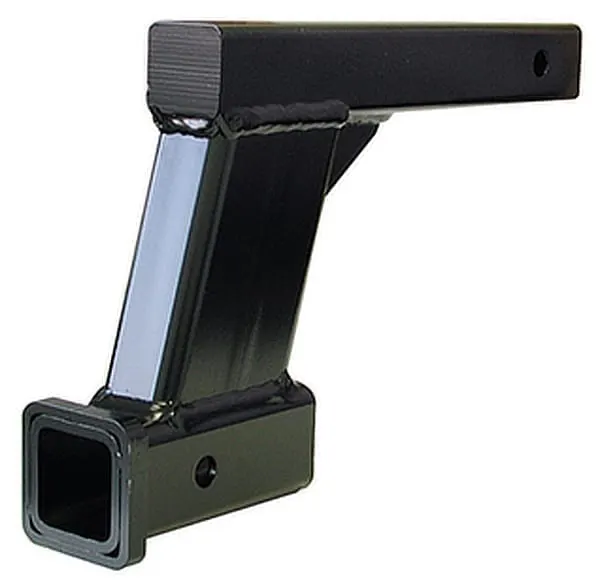
If your RV’s hitch receiver is too high up, a hi-low adapter, known as a “drop hitch”, ensures your RV tow dolly remains properly level. RV tow bars may require a drop hitch, too.
Slow Down
Improperly loading your car onto the RV tow dolly or packing it full of cargo can cause issues like whipping, where the car sways radically back and forth. Of course, swaying can happen even when you do everything right. But, if you notice side-to-side movement, slowing down is often the solution.
Check Your Tire Pressures
Before moving your rig, follow some basic safety checks as part of your overall pre-trip inspection. The importance of safety is magnified when towing a vehicle. Always check the tire pressures on your RV, car, and tow dolly. Your owner’s manuals will specify optimal pressure for each, and proper tire inflation improves safety and contributes to greater fuel efficiency.
Don’t Back Up
As with towing four down, when towing your vehicle using an RV tow dolly, you cannot backup. Because of the geometry, you risk damaging the dolly, your towed car, and/or your RV. It’s basically the same as if you tried to push a grocery store shopping cart backwards, where the steerable wheels were now at the back… it’s VERY hard to do and it will tend to want to jackknife on you. If you get into a situation where you need to back up, it’s best to disconnect the dolly and move the two vehicles separately.
Drawbacks to Choosing an RV Tow Dolly
So with all this information, especially the list of benefits we mentioned at the top of this article, you may be asking “If dollies are so great, why don’t the RVgeeks tow their car with one?”
Flat-towing is definitely more expensive than dolly towing. In the same way we answer the question “How long before my solar panels pay for themselves with free power from the sun?” it’s not about the price for us, it’s about quality of life. Flat towing is faster and easier to connect and disconnect, and takes up virtually no additional space in a campsite.
That’s not to say that price isn’t an important consideration. But if you RV often, especially full-time, and have the budget (and a flat-towable car), flat-towing 4-wheels-down is still our preferred way of towing.
But, as my mom likes to say “That’s why they make vanilla and chocolate.” The way we RV isn’t right for everyone, and we recognize the advantages and disadvantages of various choices. For many people, dolly-towing is their perfect flavor!
Education in Towing is Key
Educating yourself about your rig, your car, and the different tow dolly options will help you to make an informed decision, and tow safely.

The bigger your rig, the more sense it makes to have a tow vehicle. We all know how burdensome it is to pack up and move from one site to another. And none of us wants to do that every time we leave camp.
Selecting the right vehicle and tow dolly can make your travels much easier and more fun!
You’re All Set Up To Tow. Where To Now?!
Whether you choose a dolly, tow bar, or trailer, you’re bringing a satellite vehicle along for the purpose of getting out of your campsite and exploring! How about one of our favorite destinations — Zion National Park! Peter’s very first national park was Zion, and his very first hike there was iconic Angels Landing.
Join us in this week’s video, as we take you through this incredible hike. But leave your fear of heights behind as we scale the chains to the summit!
Watch The Video
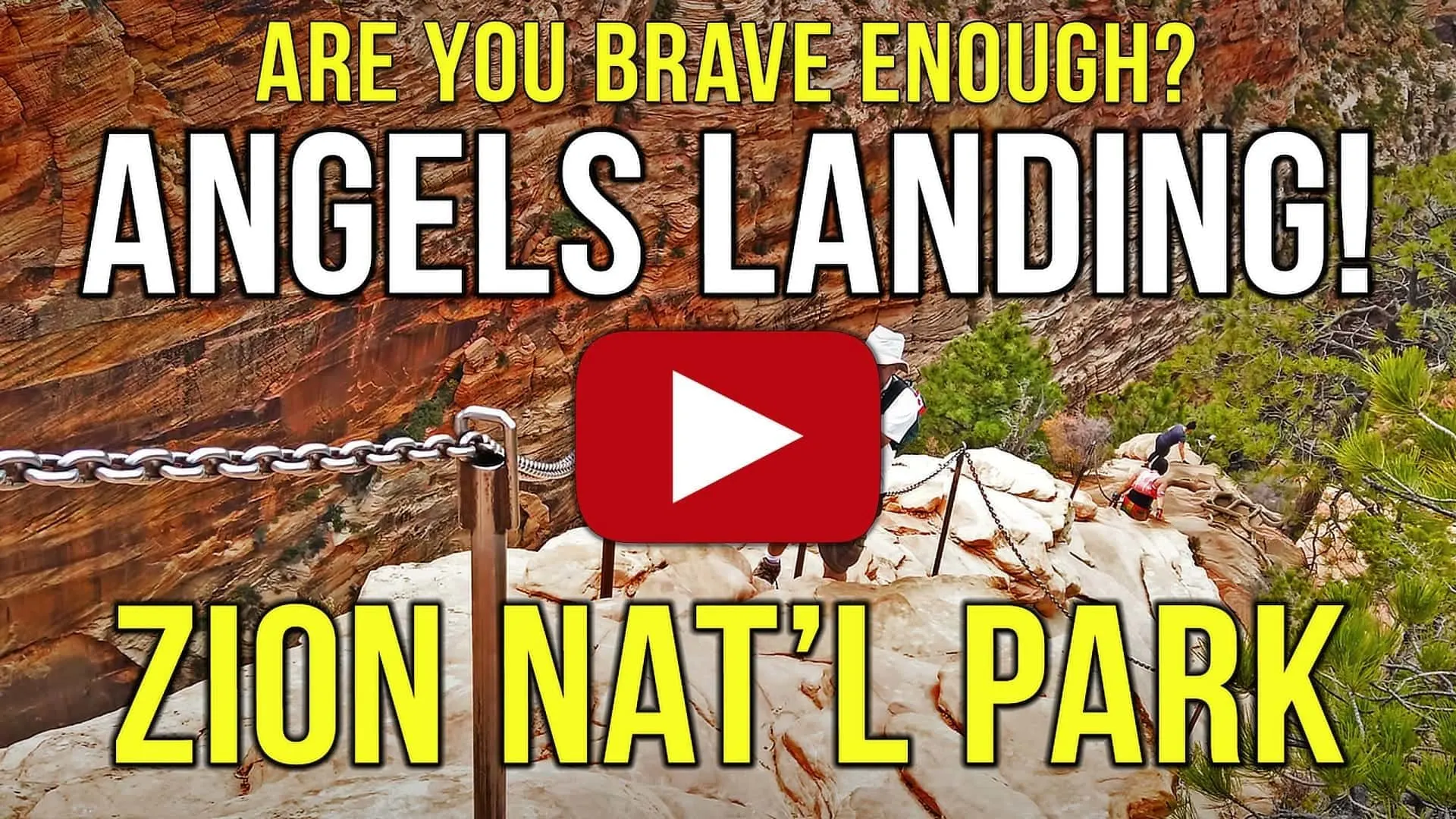
Fasten your seatbelt and enjoy a video showing the dizzying views from the Angels Landing hike in Zion National Park.
The footage we shot on this trip is included in an awesome segment about the national parks in Season 3, Episode 5 of The RVers. That episode airs on the Discovery Channel on Saturday, June 12, 2021 at 8 am Eastern & Pacific, 7 am Central, and 9 am Mountain time. Be sure to set your alarm, or your DVR! Or you can check out our page all about The RVers for lots of other ways to watch the show.
And if you want to get into the Watchman Campground in Zion National Park, but it’s all booked up, consider using the awesome service offered by CampNab (read more about CampNab here). Pick your dates & site size and then let their system regularly monitor for cancellations. They’ll text you when one occurs, so you can go nab the site on Recreation.gov! It’s worth every penny… and how we booked our stay for this trip, with only 10 days notice we would be there!
Geek Out with Us Every Week
Join our newsletter to learn about all things RV-related. Every week we offer free tips, tricks, product reviews, and more to our online community of RVers. Whether this is your first time on the road or you’re a seasoned expert, we’d love for you to geek out with us!




Roger Harris
Monday 8th of August 2022
The article on dolly towing was very helpful Especially the part about locking my steering wheel on a pivoting dolly on our way soon from home (PENTICTON) to Jasper Geek on Guys ????????????
Dr. Michael
Saturday 12th of June 2021
What are your thoughts about renting (U-Haul or Penske) a four wheel tow trailer for the occasional user?
TheRVgeeks
Sunday 13th of June 2021
That sounds like a great idea, Michael! Especially if it’s very occasional. No sense dealing with storing it all year if you only need it once or twice.
Pat Parker
Wednesday 9th of June 2021
Wow that was absolutely wonderful. The colours were superb but John you were too close to the edge many times….lol
TheRVgeeks
Wednesday 9th of June 2021
That John is a daredevil! LOL Thanks ladies!????